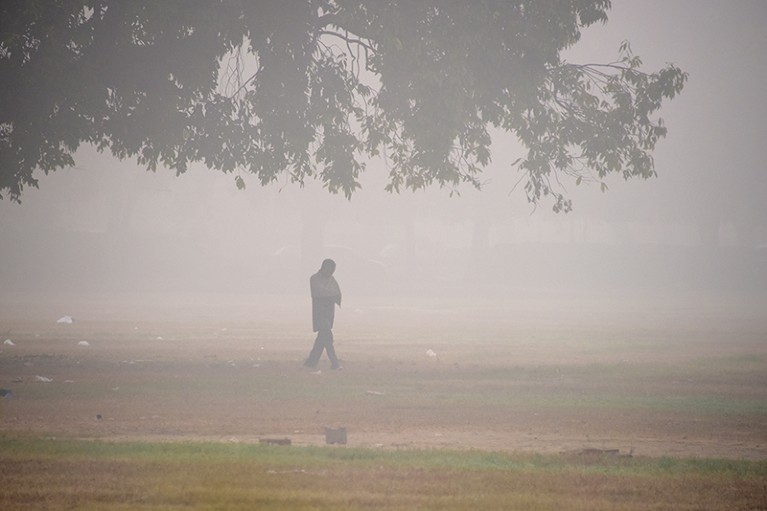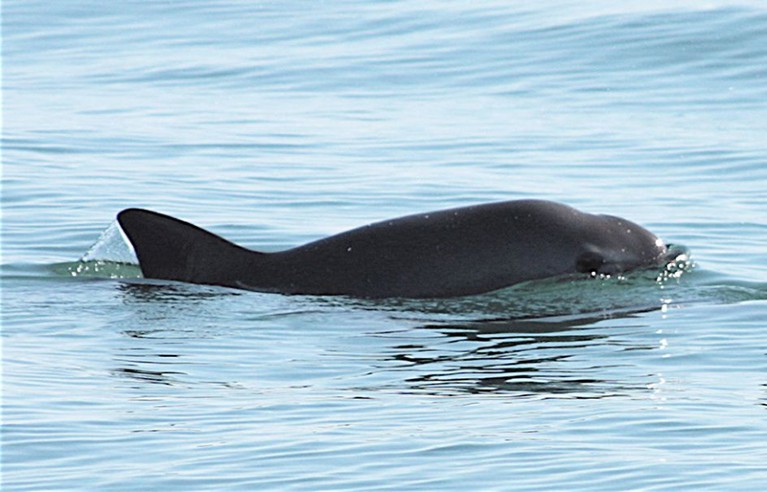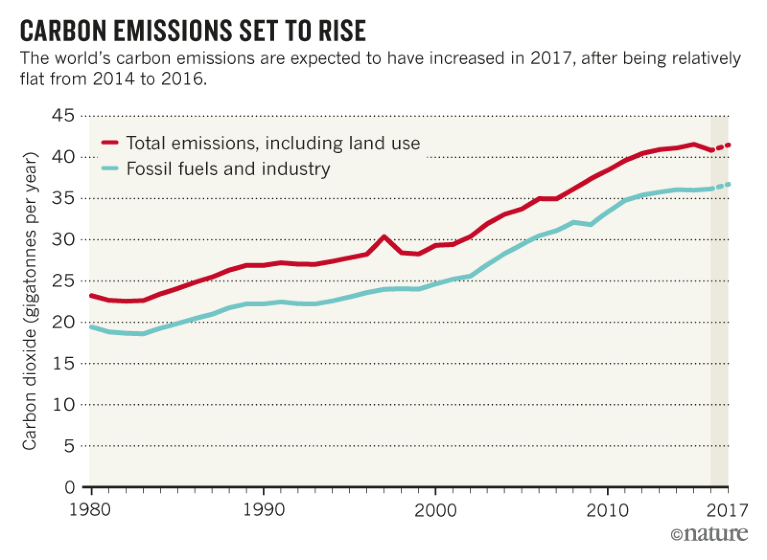EVENTS
Delhi chokes on thick winter smog Soaring air pollution in India’s capital, New Delhi, has led physicians to declare the situation a public-health emergency. In parts of the city, concentrations of particles smaller than 2.5 micrometres across (PM2.5) — the most dangerous to human health — have exceeded the level considered hazardous to people. Air quality worsens in Delhi during the winter, when farmers in nearby states burn crop stubble and cool air traps pollutants close to the ground. India’s Environment Pollution Authority ordered the closure of brick kilns and some roads, along with increases in public-transport services. It also advised schools to stop outdoor activities.

An Indian man walks amid heavy smog near India Gate in New Delhi on 13 November 2017. Credit: Dominique Faget/AFP/Getty
Iran–Iraq quake More than 450 people were killed when a magnitude-7.3 earthquake struck near the Iran–Iraq border on 12 November. The quake, which happened near the boundary of the Arabian and Eurasian tectonic plates, struck at a depth of about 20 kilometres — shallow enough to cause very strong ground shaking and topple mud-brick buildings. It also triggered several landslides in the mountainous region, cutting off rescue efforts to remote villages.
High-energy wishes Astroparticle physicists in Europe have set out their research priorities for the next decade, in a strategy document released on 13 November. The Astroparticle Physics European Consortium (APPEC) coordinates funding agencies from 14 European countries to develop Earth-based experiments that observe the cosmos by catching and analysing high-energy particles. Among the top priorities is KM3NeT, a high-energy-neutrino observatory being built in waters off Italy and France, and the planned Cherenkov Telescope Array, which will detect γ-rays hitting the atmosphere above Chile and Spain’s Canary Islands. APPEC is also pushing for a next-generation gravitational-wave interferometer and a scaling up of attempts to detect possible dark-matter particles using liquid noble gases.
FACILITIES
Regenerative hub Local officials and scientists unveiled plans for a huge regenerative-medicine research facility in the Chinese city of Guangzhou on 11 November, at a meeting of the International Society for Stem Cell Research. Details of the proposal are being finalized, but the scientists behind the project say that the city will devote billions of yuan to the centre, which is tentatively called the Guangzhou Regenerative Medicine and Health Laboratory. It will be built at the city’s existing biomedical hub and will host some 300 research groups and 3,000–6,000 researchers, in areas ranging from basic science to commercialization. The facility will focus chiefly on cell-based therapies and gene editing, and will also have a monkey research centre. Pei Duanqing, director-general of the Guangzhou Institutes of Biomedicine and Health and the laboratory’s interim director, hopes that at least 15% of the scientists will be hired from abroad.
Hawaii lawsuit A Hawaiian agency in charge of improving conditions for Native Hawaiians has sued the state government and the University of Hawaii. The Office of Hawaiian Affairs alleges that the two bodies have failed to properly care for the natural and cultural resources of Mauna Kea, a mountain that is home to many astronomical research facilities. Some Native Hawaiians say the scientific development has violated a site that they hold sacred. The lawsuit, filed on 7 November, asks a circuit court to terminate the university’s lease on Mauna Kea. A spokesman for the university said that it has made great strides in better managing and protecting the mountain.
CONSERVATION
Porpoise project Conservationists have given up trying to capture some of the last remaining members of a rare porpoise species, the vaquita (Phocoena sinus), which lives only in Mexico’s Gulf of California. The last-ditch effort, led by Mexico’s environment ministry, aimed to capture vaquitas and put them in sea pens to protect them from the fishing nets that entangle and kill them. But a vaquita calf captured on 18 October soon showed signs of stress and was released, and on 4 November a female vaquita died within hours of being captured. Fewer than 30 animals are thought to remain in the wild.

A vaquita in the Upper Gulf of California in Mexico.Credit: SEMARNAT/EPA/REX/Shutterstock
CLIMATE
La Niña returns A weak La Niña weather pattern has emerged in the east-central Pacific Ocean near the Equator, the US National Oceanic and Atmospheric Administration (NOAA) said on 9 November. The weather system, marked by low sea surface temperatures, will probably continue through the winter season in the Northern Hemisphere. La Niña usually affects rainfall patterns throughout the tropical Pacific Ocean; some places, such as northern Australia, are likely to become wetter than normal, whereas others may become drier. There is a 50% chance that the weather pattern will persist to the end of April, NOAA said.
SPACE
Rocket delay NASA probably will not fly its new heavy-lift rocket, the Space Launch System (SLS), until at least June 2020. The US Government Accountability Office had warned of delays, and the space agency announced on 8 November that it would now aim for December 2019 for the first launch — a year later than expected. But June 2020 is more likely, the agency said, given issues with manufacturing and producing all the parts for the rocket. The SLS is designed to ferry US astronauts into deep space for the first time. Its first crewed flight is scheduled for 2023.
PEOPLE
UK science adviser Patrick Vallance, president of research and development at pharmaceutical giant GlaxoSmithKline, will be Britain’s next chief scientific adviser, the UK government said on 8 November. Vallance, a clinical pharmacologist, will take up the post in April 2018. See page 282 for more.
UNESCO chief Former French culture minister Audrey Azoulay was appointed as the next director-general of the United Nations Educational, Scientific and Cultural Organization (UNESCO) on 10 November. She becomes the second woman to hold the position since the organization was founded in 1945. Among other roles, UNESCO supports sustainable science and international access to scientific advances. It also keeps the World Heritage List, which legally protects sites of natural or cultural importance through international treaties. Azoulay served in the French government for 15 months from February 2016, and played a key part in international efforts to safeguard cultural heritage in conflict zones, particularly the Middle East.
US health secretary US President Donald Trump has nominated pharmaceutical executive Alex Azar to be the next secretary of the US Department of Health and Human Services (HHS). Azar served as HHS deputy secretary under then-president George W. Bush, and headed the US division of drug giant Eli Lilly in Indianapolis, Indiana, for five years, starting in 2012. If confirmed by the US Senate, Azar would replace former HHS secretary Tom Price, who resigned in September amid criticism of his use of government funds to travel on private planes. Trump announced the pick in a tweet on 13 November.
Iranian scientist The European University Association has urged the Iranian authorities to reverse the death sentence against disaster-medicine researcher Ahmadreza Djalali and release him, in a letter dated 13 November. Djalali, an Iranian who worked in Sweden, was arrested in Tehran in April 2016 and sentenced to death this October for espionage after a trial in Iran’s revolutionary court. He filed an appeal against the conviction on 5 November, his wife told Nature. A document attributed to Djalali says that he is being punished because he refused to spy for Iran. Directors of Swedish, Italian and Belgian research institutions that employed Djalali also demanded his release in a letter to the Iranian judiciary. Italian senators have sought to suspend a memorandum of scientific cooperation, signed with Iran in April, over the issue.
TREND WATCH
Humanity’s carbon emissions are likely to have surged by 2% in 2017, driven mainly by increased coal use in China, scientists at the Global Carbon Project reported on 13 November at the United Nations climate talks in Bonn, Germany. The rise would end three years of flat emissions. Carbon emissions in the United States and the European Union are predicted to decline this year, but to rise in China by 3.5%. Global carbon dioxide emissions could reach 41.5 billion tonnes in 2017, the analysis says.

Source: G. P. Peters et al. Nature Clim. Change http://dx.doi.org/10.1038/s41558-017-0013-9 (2017)



